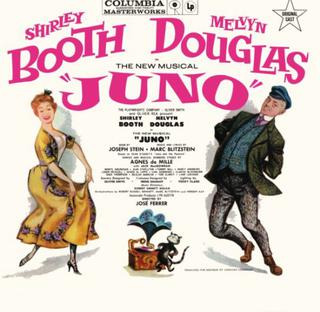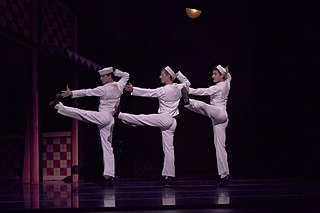
Paint Your Wagon is a Broadway musical comedy, with book and lyrics by Alan J. Lerner and music by Frederick Loewe. The story centers on a miner and his daughter and follows the lives and loves of the people in a mining camp in Gold Rush-era California. Popular songs from the show included "Wand'rin' Star", "I Talk to the Trees", and "They Call the Wind Maria".

Oklahoma! is the first musical written by the duo of Rodgers and Hammerstein. The musical is based on Lynn Riggs's 1931 play, Green Grow the Lilacs. Set in farm country outside the town of Claremore, Indian Territory, in 1906, it tells the story of farm girl Laurey Williams and her courtship by two rival suitors, cowboy Curly McLain and the sinister and frightening farmhand Jud Fry. A secondary romance concerns cowboy Will Parker and his flirtatious fiancée, Ado Annie.

Agnes George de Mille was an American dancer and choreographer.

Jerome Robbins was an American dancer, choreographer, film director, theatre director and producer who worked in classical ballet, on stage, film, and television.
Song of Norway is an operetta written in 1944 by Robert Wright and George Forrest, adapted from the music of Edvard Grieg and the book by Milton Lazarus and Homer Curran. A very loose film adaptation with major changes to both the book and music was released in 1970.

James Mitchell was an American actor and dancer. Although he is best known to television audiences as Palmer Cortlandt on the soap opera All My Children (1979–2010), theatre and dance historians remember him as one of Agnes de Mille's leading dancers. Mitchell's skill at combining dance and acting was considered something of a novelty; in 1959, the critic Olga Maynard singled him out as "an important example of the new dancer-actor-singer in American ballet", pointing to his interpretive abilities and "masculine" technique.

A dream ballet, in musical theater, is an all-dance, no-singing production number that reflects the themes of the production. The plot, themes, and characters are typically the same—although the people playing the characters may be different, as the roles of the dream ballet are usually filled by well-trained dancers rather than actual actors.

Gemze de Lappe was an American dancer who worked very closely with Agnes de Mille and was frequently partnered by de Mille's favorite male dancer, James Mitchell.

Juno is a musical with music and lyrics by Marc Blitzstein and book by Joseph Stein, based closely on the 1924 play Juno and the Paycock by Seán O'Casey. The story centers on the disintegration of an Irish family in Dublin in the early 1920s, during the Irish War of Independence. Juno is a hardworking matriarch who strives to hold her family together in the face of war, betrayal, and her worthless husband's drinking.
Lidija Franklin was an American dancer and teacher of Latvian descent, originally from the Moscow area. In the United States, she was known primarily for her association with Agnes de Mille.
Billion Dollar Baby is a musical with the book and lyrics by Betty Comden and Adolph Green and the score by Morton Gould. Comden and Green were fresh from their success with On the Town, and the production team was something of an On the Town reunion: once again, George Abbott directed and Jerome Robbins choreographed.
Dania Krupska was an American dancer and choreographer.
Graciela Daniele is an Argentine-American dancer, choreographer, and theatre director.

Fancy Free is a ballet composed in 1944 by Leonard Bernstein. The Ballet Theatre premiered the ballet with choreography by Jerome Robbins, scenery by Oliver Smith, costumes by Kermit Love, and lighting by Ronald Bates. The premiere took place on Tuesday, 18 April 1944 at the old Metropolitan Opera House, New York. The New York City Ballet premiere took place on Thursday, 31 January 1980. Fancy Free provided the basis for the later musical, On the Town. A portion of the score was also used in the opening scenes of Alfred Hitchcock's Rear Window.
The Donaldson Awards were a set of theatre awards established in 1944 by the drama critic Robert Francis in honor of W. H. Donaldson (1864–1925), the founder of The Billboard magazine.
Gertrud Rittmann was a German Jewish composer, musical director, arranger and orchestrator who lived and worked for much of her life in the United States. Her career particularly flourished with major successes in Broadway theater.

Virginia Bosler, known to friends by her childhood nickname "Winkie", was an American actress born in Newton, Massachusetts. She was known for acting in Broadway musicals.

The Greenwich Village Follies was a musical revue that played for eight seasons in New York City from 1919 to 1927. Launched by John Murray Anderson, and opening on July 15, 1919, at the newly constructed Greenwich Village Theatre near Christopher Street, the show's success has been credited in part to its timing: as a non-union production, it was unaffected by the then-current actors' strike.
Lemuel Ayers was an American costume designer, scenic designer, lighting designer, and producer who had a prolific career on Broadway from 1939 until his death from cancer in 1955 at the age of 40. He designed sets for a total of 30 Broadway plays and musicals during his career, including both the original 1943 production and 1951 revival of Rodgers and Hammerstein's Pulitzer Prize winning musical Oklahoma!. Ayers also designed both costumes and sets for several productions, including St. Louis Woman (1946), My Darlin' Aida (1952), Kismet (1953), and The Pajama Game (1954). He served as lighting designer and scenic designer for one production, Harold Arlen's Bloomer Girl (1944), and he designed the entire productions of Song of Norway (1944) and Arthur Schwartz's Inside U.S.A. (1948). He won three Tony Awards in 1949, for the original production of Cole Porter's Kiss Me, Kate (1948), for which he designed both costumes and sets and worked as producer. He also directed portions of the 1945 musical film Ziegfeld Follies for MGM for which he also served as art director. He also worked as art director for the musical film Meet Me in St. Louis with Judy Garland and directed portions of the musical film Kiss Me Kate (1953).
Muriel Siegal Bentley was an American ballet dancer. She was a member of the Ballet Theatre of New York. She created roles in works by Antony Tudor, Agnes de Mille and Jerome Robbins, and danced the role of Anita in West Side Story on Broadway from 1957 to 1959.












